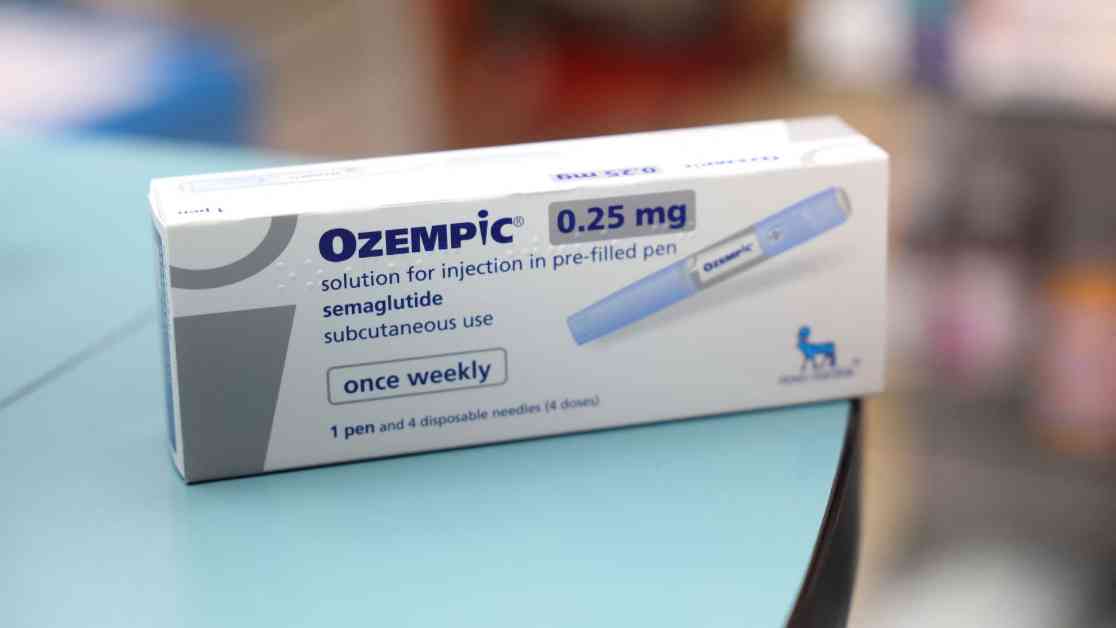Novo Nordisk’s Ozempic Shows Promise in Reducing Opioid Overdoses
A recent study has shed light on the potential of Novo Nordisk’s diabetes drug, Ozempic, in reducing the risk of opioid overdoses in certain patients. The study, published in JAMA Network Open, revealed that the active ingredient in Ozempic, semaglutide, was associated with a significantly lower risk of opioid overdoses compared to other diabetes medications in individuals with Type 2 diabetes and opioid use disorder.
The findings of the study have significant implications for addressing the ongoing opioid epidemic in the United States, which has been declared a public health emergency. According to lead study co-author Dr. Rong Xu, a biomedical informatics professor at Case Western Reserve University, there is a need for alternative treatments for opioid use disorder as some patients do not utilize existing medications effectively.
Currently, only about a quarter of patients with opioid use disorder receive recommended medications, and many discontinue treatment within six months, as reported by the Centers for Disease Control and Prevention. Opioids are a contributing factor in approximately 72% of overdose deaths in the U.S., highlighting the urgent need for effective interventions.
The study also adds to the growing body of evidence supporting the health benefits of GLP-1 medications, such as Ozempic, beyond their primary function of regulating blood sugar and promoting weight loss. Novo Nordisk, along with its competitors like Eli Lilly, has been exploring the potential of GLP-1 drugs in treating various chronic conditions, including addictive behaviors like nicotine and alcohol use.
Detailed Analysis of the Study Results
Researchers from Case Western Reserve University and the National Institutes of Health conducted a comprehensive analysis of electronic health records of nearly 33,000 patients who were prescribed semaglutide or other diabetes medications between December 2017 and June 2023. The study, which was not funded by Novo Nordisk, found that approximately 3,000 patients were prescribed semaglutide injections, while the rest received a range of treatments for diabetes, including insulins and older GLP-1 medications.
During a one-year follow-up period after discontinuing treatment, the researchers observed a lower incidence of opioid overdoses among patients who had taken semaglutide compared to those who had received other medications. Specifically, there were 42 cases of opioid overdose in the semaglutide group, compared to 97 cases in the group that received insulins, indicating a 58% lower risk of opioid overdose in patients treated with semaglutide.
However, it is essential to note that the study has limitations due to its reliance on electronic health records. Further research, including randomized clinical trials, is needed to validate the efficacy of Ozempic and other GLP-1 medications in treating opioid use disorder. These trials can help determine the broader impact of GLP-1 drugs on the general population with opioid use disorder and identify specific patient groups that may benefit the most from this treatment approach.
Future Directions and Potential Impact
Dr. Nora Volkow, lead study co-author and director of the National Institute on Drug Abuse, emphasized the need for additional research to explore the potential benefits of GLP-1 medications in preventing opioid overdoses. While the preliminary findings are promising, further studies are required to establish the effectiveness of GLP-1 drugs in reducing opioid-related harm and improving outcomes for patients with opioid use disorder.
Moving forward, the researchers plan to investigate the use of semaglutide in patients with opioid use disorder and obesity, highlighting the potential of Ozempic as a multifaceted treatment option for individuals facing complex health challenges. By leveraging the therapeutic benefits of GLP-1 medications, healthcare providers may be able to offer more comprehensive and personalized care to patients struggling with opioid addiction and related complications.
Exploring the Mechanisms of Action
The study findings raise intriguing questions about the underlying mechanisms through which GLP-1 medications like Ozempic may influence opioid use disorder and overdose risk. While the precise pathways are not yet fully understood, researchers speculate that the effects of GLP-1 drugs on brain function, metabolism, and inflammation could play a role in modulating addictive behaviors and mitigating the consequences of opioid misuse.
GLP-1 receptors are widely distributed throughout the brain and body, indicating their potential to impact a range of physiological processes beyond glycemic control. By targeting these receptors, GLP-1 medications may exert neuroprotective effects and regulate reward pathways associated with substance abuse, offering a novel approach to managing addictive disorders.
Furthermore, the anti-inflammatory properties of GLP-1 drugs could contribute to reducing the systemic inflammation often observed in individuals with opioid use disorder. Chronic inflammation is a hallmark of opioid addiction and can exacerbate the risk of complications such as overdose and organ damage. By addressing inflammation through GLP-1 therapy, patients may experience improved overall health outcomes and reduced vulnerability to opioid-related harm.
Implications for Clinical Practice and Public Health
The potential of Ozempic and other GLP-1 medications in addressing opioid overdoses underscores the importance of integrating innovative treatment approaches into clinical practice and public health initiatives. Healthcare providers and policymakers must collaborate to ensure that evidence-based interventions, such as GLP-1 therapy, are accessible to individuals at risk of opioid misuse and overdose.
By expanding the use of GLP-1 drugs in populations with opioid use disorder, healthcare systems can enhance the effectiveness of existing treatment strategies and reduce the burden of opioid-related morbidity and mortality. Through targeted interventions and comprehensive care plans, patients can receive tailored support to manage their addiction and improve their overall well-being.
In conclusion, the study on the potential of Ozempic in reducing opioid overdoses represents a significant step forward in addressing the complex challenges posed by the opioid epidemic. By leveraging the therapeutic properties of GLP-1 medications, healthcare providers have an opportunity to revolutionize the management of opioid use disorder and enhance the quality of life for individuals struggling with addiction. Further research and clinical trials will be crucial in validating the efficacy of GLP-1 drugs and expanding their use in diverse patient populations, ultimately shaping a more effective and compassionate approach to tackling the opioid crisis.






















